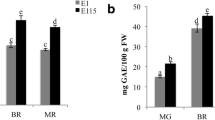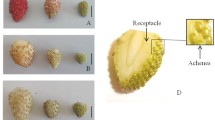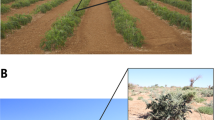Abstract
Main conclusion
Andean tomatoes differed from the wild ancestor in the metabolic composition and the expression of genes related with mitochondrial functions, and environmental stresses, making them potentially suitable for breeding programmes.
Abstract
Traditional landraces or “criollo” tomatoes (Solanum lycopersicum L.) from Andean areas of Argentina, selected for their fruit quality, were analysed in this study. We explored the metabolome and transcriptome of the ripe fruit in nine landrace accessions representing the seven genetic groups and compared them to the mature fruit of the wild progenitor Solanum pimpinellifolium. The content of branched- (isoleucine and valine) and aromatic (phenylalanine and tryptophan) amino acids, citrate and sugars were significantly different in the fruit of several “criollo” tomatoes compared to S. pimpinellifolium. The transcriptomic profile of the ripe fruit showed several genes significantly and highly regulated in all varieties compared to S. pimpinellifolium, like genes encoding histones and mitochondrial proteins. Additionally, network analysis including transcripts and metabolites identified major hubs with the largest number of connections such as constitutive photomorphogenic protein 1 (a RING finger-type ubiquitin E3 ligase), five Zn finger transcription factors, ascorbate peroxidase, acetolactate synthase, and sucrose non-fermenting 1 kinase. Co-expression analysis of these genes revealed a potential function in acquiring tomato fruit quality during domestication.



Similar content being viewed by others
Data availability
The data sets generated during the current study are available in the GEO repository under number GSE125476.
Abbreviations
- APX:
-
Ascorbate peroxidase
- COP1:
-
Constitutive photomorphogenic 1
- GO:
-
Gene ontology
- PCA:
-
Principal component analysis
- SNF1:
-
Sucrose non-fermenting 1 kinase
References
Asprelli PD, Robbins M, Sim S, García Lampasona SM, Francis DM, Peralta IE (2012) Perfiles fenotípicos y genéticos de una colección de tomates criollos de Argentina. J Basic Appl Genet Suppl XXIII(1):349
Asprelli PD, Sance MM, Insani EM, Asis R, Valle EM, Carrari F, Galmarini CR, Peralta IE (2017) Agronomic performance and fruit nutritional quality of an Andean tomato collection. Acta Hortic 1159:197–204
Bauchet G, Causse M (2012) Genetic diversity in tomato (Solanum lycopersicum) and its wild relatives. Genetic diversity in plants. In: Caliskan M (ed) Genetic diversity in plants. ISBN: 978-953-51-0185-7. InTechOpen, https://doi.org/10.5772/33073
Blanca J, Cañizares J, Cordero L, Pascual L, Diez MJ, Nuez F (2013) Variation revealed by SNP genotyping and morphology provides insight into the origin of the tomato. PLoS One 7:e48198
Carrari F, Baxter C, Usadel B, Urbanczyk-Wochniak E, Zanor MI, Nunes-Nesi A, Nikiforova V, Centero D, Ratzka A, Pauly M, Sweetlove LJ, Fernie AR (2006) Integrated analysis of metabolite and transcript levels reveals the metabolic shifts that underlie tomato fruit development and highlight regulatory aspects of metabolic network behavior. Plant Physiol 142:1380–1396
Carroll SB (2008) Evo-devo and an expanding evolutionary synthesis: a genetic theory of morphological evolution. Cell 134:25–36
Cortina PR, Santiago AN, Sance MM, Peralta IE, Carrari F, Asís R (2018) Neuronal network analyses reveal novel associations between volatile organic compounds and sensory properties of tomato fruits. Metabolomics 14:57
D’Angelo M, Zanor MI, Sance M, Cortina PR, Boggio SB, Asprelli P, Carrari F, Santiago AN, Asís R, Peralta IE, Valle EM (2018) Contrasting metabolic profiles of tasty tomato fruit of the Andean varieties in comparison with commercial ones. J Sci Food Agric 98:4128–4134
D’Esposito D, Ferriello F, Dal Molin A, Diretto G, Sacco A, Minio A, Barone A, Di Monaco R, Cavella S, Tardella L, Giuliano G, Delledonne M, Frusciante L, Ercolano MR (2017) Unraveling the complexity of transcriptomic, metabolomic and quality environmental response of tomato fruit. BMC Plant Biol 17:66
Di Paola Naranjo RD, Otaiza S, Saragusti AC, Baroni V, Carranza AV, Peralta IE, Valle EM, Carrari F, Asís R (2016a) Data on polyphenols and biological activity analyses of an Andean tomato collection and their relationships with tomato traits and geographical origin. Data Brief 7:1258–1268
Di Paola Naranjo RD, Otaiza S, Saragusti AC, Baroni V, Carranza AV, Peralta IE, Valle EM, Carrari F, Asis R (2016b) Hydrophilic antioxidants from Andean tomato landraces assessed by their bioactivities in vitro and in vivo. Food Chem 206:146–155
Di Rienzo JA, Casanoves F, Balzarini MG, Gonzalez L, Tablada M, Robledo CW (2008) InfoStat, versión 2008. Córdoba: Grupo InfoStat, FCA, Universidad Nacional de Córdoba, Argentina
Etienne A, Génard M, Lobit P, Mbeguié-A-Mbéguié D, Bugaud C (2013) What controls fleshy fruit acidity? A review of malate and citrate accumulation in fruit cells. J Exp Bot 64:1451–1469
Fernie AR, Klee H (2011) The use of natural genetic diversity in the understanding of metabolic organization and regulation. Front Plant Sci 2:59
Fernie AR, Tohge T (2017) The genetics of plant metabolism. Annu Rev Genet 51:287–310
Fray RG, Grierson D (1993) Identification and genetic analysis of normal and mutant phytoene synthase genes of tomato by sequencing, complementation and co-suppression. Plant Mol Biol 22:589–602
Fu X, Li C, Zhou X, Liu S, Wu F (2016) Physiological response and sulfur metabolism of the V. dahliae-infected tomato plants in tomato/potato onion companion cropping. Sci Rep 6:36445
Gadea J, Conejero V, Vera P (1999) Developmental regulation of a cytosolic ascorbate peroxidase gene from tomato plants. Mol Gen Genet 262:212–219
Gao L, Gonda I, Sun H et al (2019) The tomato pan-genome uncovers new genes and a rare allele regulating fruit flavor. Nat Genet 51:1044–1051. https://doi.org/10.1038/s41588-019-0410-2
Gascuel Q, Diretto G, Monforte AJ, Fortes AM, Granell A (2017) Use of natural diversity and biotechnology to increase the quality and nutritional content of tomato and grape. Front Plant Sci 8:652
Giovannoni J (2007) Fruit ripening mutants yield insights into ripening control. Curr Opin Plant Biol 10:283–289
Giovannoni J (2018) Tomato multiomics reveals consequences of crop domestication and improvement. Cell 172:6–8
Gonzalez C, Zanor MI, Ré MD, Otaiza S, Asis R, Valle EM, Boggio SB (2019) Chilling tolerance of Micro-Tom fruit involves changes in the primary metabolite levels and in the stress response. Postharvest Biol Technol 148:58–67
González-Aguilera KL, Saad CF, Chávez Montes RA, Alves-Ferreira M, de Folter S (2016) Selection of reference genes for quantitative real-time RT-PCR studies in tomato fruit of the genotype MT-Rg1. Front Plant Sci 7:1386
Joshi V, Laubengayer KM, Schauer N, Fernie AR, Jander G (2006) Two Arabidopsis threonine aldolases are nonredundant and compete with threonine deaminase for a common substrate pool. Plant Cell 18:3564–3575
Kim J-M, To TK, Matsui A et al (2017) Acetate-mediated novel survival strategy against drought in plants. Nat Plants 3:17097
Klee HJ, Giovannoni JJ (2011) Genetics and control of tomato fruit ripening and quality attributes. Annu Rev Genet 45:41–59
Knapp S, Peralta IE (2016) The tomato (Solanum lycopersicum L. Solanaceae) and its botanical relatives. In: Causse M, Giovannoni J, Bouzayen M, Zouine M (eds) The tomato genome. Compendium of plant genomes. Springer, Berlin, pp 7–21
Koenig D, Jiménez-Gómez JM, Kimura S et al (2013) Comparative transcriptomics reveals patterns of selection in domesticated and wild tomato. Proc Natl Acad Sci USA 110:E2655–E2662
Liu Y, Roof S, Ye Z, Barry C, van Tuinen A, Vrebalov J, Bowler C, Giovannoni J (2004) Manipulation of light signal transduction as a means of modifying fruit nutritional quality in tomato. Proc Natl Acad Sci USA 101:9897–9902
Liu L, Shao Z, Zhang M, Wang Q (2015) Regulation of carotenoid metabolism in tomato. Mol Plant 8:28–39
Lohse M, Nunes-Nesi A, Kruger P, Nagel A, Hannemann J, Giorgi FM, Childs L, Osorio S, Walther D, Selbig J, Sreenivasulu N, Stitt M, Fernie AR, Usadel B (2010) Robin: an intuitive wizard application for R-based expression microarray quality assessment and analysis. Plant Physiol 153:642–651
Morgan MJ, Osorio S, Gehl B, Baxter CJ, Kruger NJ, Ratcliffe RG, Fernie AR, Sweetlove LJ (2013) Metabolic engineering of tomato fruit organic acid content guided by biochemical analysis of an introgression line. Plant Physiol 161:397–407
Mounet F, Moing A, Garcia V, Petit J, Maucourt M, Deborde C, Bernillon S, Le Gall G, Colquhoun I, Defernez M, Giraudel J-L, Rolin D, Rothan C, Lemaire-Chamley M (2009) Gene and metabolite regulatory network of early developing fruit tissues highlights new candidate genes for the control of tomato fruit composition and development. Plant Physiol 149:1505–1528
Osorio S, Scossa F, Fernie AR (2013) Molecular regulation of fruit ripening. Front Plant Sci 4:198
Peralta IE, Makuch M, García Lampasona S, Occhiuto PN, Asprelli PD, Lorello IM, Togno L (2008) Catálogo de poblaciones criollas de pimiento, tomate y zapallo colectadas en valles andinos de la Argentina. INTA, Mendoza
Purugganan MD, Fuller DQ (2009) The nature of selection during plant domestication. Nature 457:843–848
Romero IG, Ruvinsky I, Gilad Y (2012) Comparative studies of gene expression and the evolution of gene regulation. Nat Rev Genet 13:505–516
Sauvage C, Segura V, Bauchet G, Stevens R, Do PT, Nikoloski Z, Fernie AR, Causse M (2014) Genome-wide association in tomato reveals 44 candidate loci for fruit metabolic traits. Plant Physiol 165:1120–1132
Seymour GB, Chapman NH, Chew BL, Rose JK (2013) Regulation of ripening and opportunities for control in tomato and other fruits. Plant Biotechnol J 11:269–278
Shannon P, Markiel A, Ozier O, Baliga NS, Wang JT, Ramage D, Amin N, Schwikowski B, Ideker T (2003) Cytoscape: a software environment for integrated models of biomolecular interaction networks. Genome Res 13:2498–2504
Sorrequieta A, Ferraro G, Boggio SB, Valle EM (2010) Free amino acid production during tomato fruit ripening: a focus on l-glutamate. Amino Acids 38:1523–1532
Sorrequieta A, Abriata LA, Boggio SB, Valle EM (2013) Off-the-vine ripening of tomato fruit causes alteration in the primary metabolite composition. Metabolites 3:967–978
Thatcher TH, Gorovsky MA (1994) Phylogenetic analysis of the core histones H2A, H2B, H3, and H4. Nucleic Acids Res 22:174–179
Tieman DM, Zhu G, Resende MFR et al (2017) A chemical genetic roadmap to improved tomato flavor. Science 355:6323–6391
Tomato Genome Consortium (2012) The tomato genome sequence provides insights into fleshy fruit evolution. Nature 485:635–641
Wu S, Alseekh S, Cuadros-Inostroza Á, Fusari CM, Mutwil M, Kooke R, Keurentjes JB, Fernie AR, Willmitzer L, Brotman Y (2016) Combined use of genome-wide association data and correlation networks unravels key regulators of primary metabolism in Arabidopsis thaliana. PLoS Genet 12:e1006363
Xu R (2014) Genome-wide analysis and identification of stress-responsive genes of the CCCH zinc finger family in Solanum lycopersicum. Mol Genet Genomics 289:965–979
Yu W, Peng F, Xiao Y, Wang G, Luo J (2018) Overexpression of PpSnRK1α in tomato promotes fruit ripening by enhancing RIPENING INHIBITOR regulation pathway. Front Plant Sci 9:1856
Zhu Y, Dong A, Shen W-H (2013) Histone variants and chromatin assembly in plant abiotic stress responses. Biochim Biophys Acta 1819:343–348
Zhu G, Wang S, Huang Z et al (2018) Rewiring of the fruit metabolome in tomato breeding. Cell 172:249–261
Acknowledgements
We thank the Reviewers for their constructive comments to improve the quality of this manuscript. MD and EB were recipients of fellowships of Consejo Nacional de Investigaciones Científicas y Técnicas (CONICET). MIZ, SBB, FC, IEP, and EMV are career members of CONICET, and PDA is a member of the National Institute of Agricultural Technology (INTA). This work was partially supported by grant number PICT2017-0978 and PICT 2007-01942 of Agencia Nacional de Promoción Científica y Tecnológica (ANPCyT), and INTA.
Author information
Authors and Affiliations
Corresponding author
Ethics declarations
Conflict of interest
The authors declare that they have no conflict of interest.
Additional information
Publisher's Note
Springer Nature remains neutral with regard to jurisdictional claims in published maps and institutional affiliations.
Electronic supplementary material
Below is the link to the electronic supplementary material.
Rights and permissions
About this article
Cite this article
D’Angelo, M., Zanor, M.I., Burgos, E. et al. Fruit metabolic and transcriptional programs differentiate among Andean tomato (Solanum lycopersicum L.) accessions. Planta 250, 1927–1940 (2019). https://doi.org/10.1007/s00425-019-03274-4
Received:
Accepted:
Published:
Issue Date:
DOI: https://doi.org/10.1007/s00425-019-03274-4




